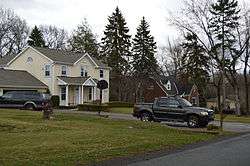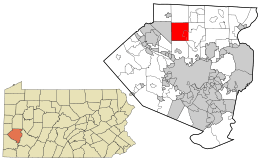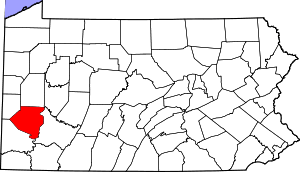McCandless, Pennsylvania
McCandless is a township with home rule status in Allegheny County, Pennsylvania, United States. The population was 28,457 at the 2010 census.[3] It obtained a home rule charter on January 1, 1975, and changed its name from "McCandless Township" to "Town of McCandless".[4] Though McCandless no longer operates under the First Class Township Code, it is classified as a first-class township for certain purposes.[5][6][7]
McCandless, Allegheny County, Pennsylvania | |
|---|---|
 Typical suburban street | |
 Location in Allegheny County and state of Pennsylvania | |
| Coordinates: 40.57651°N 80.029292°W | |
| Country | United States |
| State | Pennsylvania |
| County | Allegheny |
| Settled | 1796 |
| Incorporated | 1851 |
| Government | |
| • Type | Town Council |
| • Council President | Kimberly K. Zachary (R) |
| • Town Manager | Tobias M. Cordek |
| Area | |
| • Total | 16.60 sq mi (43.00 km2) |
| • Land | 16.50 sq mi (42.73 km2) |
| • Water | 0.10 sq mi (0.27 km2) |
| Elevation | 1,024 ft (312 m) |
| Population (2010) | |
| • Total | 28,457 |
| • Estimate (2018)[2] | 28,311 |
| • Density | 1,742.83/sq mi (672.92/km2) |
| Time zone | UTC−5 (Eastern (EST)) |
| • Summer (DST) | UTC−4 (EDT) |
| ZIP code | 15237, 15090, 15101, 15127 |
| Area code(s) | 412, 724, 878 |
| FIPS code | 42-003-45900 |
| Website | McCandless official website |
The inclusion of the word "Town" in its name sometimes causes confusion, since with one exception, a "town" is not a municipal unit in Pennsylvania. Bloomsburg, in Columbia County, was incorporated as a town in 1870, and is legally recognized as "the only incorporated town" in Pennsylvania.
McCandless is part of the North Allegheny School District and participates in the multi-municipality Northland Public Library.
It has been ranked highly among Money Magazine's "Best Places to Live."[8][9]
History
Native American artifacts, primarily Iroquois Nation, have been found in areas of the township. Early written history includes a visit by George Washington and his guide, Christopher Gist, in 1753.
The state of Pennsylvania enacted legislation in order to gain Continental Script, a quickly depreciating currency during the Revolutionary War. The legislation ordered for a plan to sell Iroquois land that was known as the Depreciation Lands at the time; this land included the North Hills. Soldiers redeemed their certificates by receiving cash or Iroquois land. Because of this, Iroquois unrest emerged and did not stop until the Iroquois were defeated in 1794. [10]
The first European settler in McCandless Township was James Duff, who had purchased 400 acres (1.6 km2) in 1796. Farming increased in the area, and in 1849, meetings were held, presided over by Daniel Vogel, for the purpose of forming a local government. The township was founded in 1851 and called "Taylor Township". The area was incorporated in 1857 as a second class township and renamed "McCandless Township" in honor of District Judge Wilson McCandless. The published population was 1,482 persons.
During the 1800s McCandless Township was primarily a farming community. During the War of 1812, an important supply route for the transportation of war materials from Pittsburgh to Commodore Perry's forces on Lake Erie passed through the area.
In 1908 an interurban commuter railroad, the Harmony Line, allowed area residents to easily commute to Pittsburgh. A concurrent oil boom resulted in rapid early development, centered on the rail stations in the Highland and Ingomar areas.
By 1931, the Harmony Line was closed because of the popularity of the automobile.
Allegheny County Commissioner E. V. Babcock initiated the establishment of Allegheny County's North Park. He purchased the land and later sold it to the county at cost. North Park was founded in 1927 by Allegheny County. Approximately 1,600 acres (6.5 km2) of the park, 2.5 square miles (6.5 km2), are located in McCandless. This area represents approximately 15.2% of the town.
Between 1930 and 1950, the town more than doubled its population (from 2,653 to 6,488). By 1960, the population had redoubled (14,582) and has since doubled again. At the 2000 census, the number of households in the town was 11,159.
Expanding population and traffic brought more diversified development into the area. McKnight Road was built in the mid 1950s and became the primary access into the north suburban areas. Retail and office uses occupy some of the McCandless segment of the McKnight corridor. The Community College of Allegheny County opened a campus in the area in 1972. A new mixed-use development acting as a town center, McCandless Crossing, was completed in 2016 and serves as a strip mall as well as an apartment complex and a townhome neighborhood.[11]
Geography
According to the United States Census Bureau, the township has a total area of 16.6 square miles (43 km2), of which 16.5 square miles (43 km2) is land and 0.1 square miles (0.26 km2), or 0.66%, is water.
The municipality lies on the Allegheny Plateau and is characterized by generally hilly terrain. A floodplain lies in the area of Pine Creek, which cuts a deep valley through the central portion of the township.
Surrounding neighborhoods
McCandless has four borders, including Pine Township to the north, Hampton Township to the east, Ross Township to the south and the borough of Franklin Park to the west.
Demographics
| Historical population | |||
|---|---|---|---|
| Census | Pop. | %± | |
| 1860 | 1,482 | — | |
| 1870 | 957 | −35.4% | |
| 1880 | 1,010 | 5.5% | |
| 1890 | 985 | −2.5% | |
| 1900 | 1,034 | 5.0% | |
| 1910 | 987 | −4.5% | |
| 1920 | 1,465 | 48.4% | |
| 1930 | 2,053 | 40.1% | |
| 1940 | 3,494 | 70.2% | |
| 1950 | 6,488 | 85.7% | |
| 1960 | 14,582 | 124.8% | |
| 1970 | 22,404 | 53.6% | |
| 1980 | 26,191 | 16.9% | |
| 1990 | 28,781 | 9.9% | |
| 2000 | 29,022 | 0.8% | |
| 2010 | 28,457 | −1.9% | |
| Est. 2018 | 28,311 | [2] | −0.5% |
| Sources:[12][13][14][15][16][17][18][19] | |||
As of the census[18] of 2000, there were 29,022 people, 11,159 households, and 7,922 families residing in the township. The population density was 1,754.4 people per square mile (677.5/km²). There were 11,697 housing units at an average density of 707.1 per square mile (273.0/km²). The racial makeup of the township was 94.58% White, 1.29% African American, 0.05% Native American, 3.19% Asian, 0.01% Pacific Islander, 0.14% from other races, and 0.74% from two or more races. Hispanics or Latinos of any race were 0.70% of the population.
There were 11,159 households, out of which 32.2% had children under the age of 18 living with them, 62.8% were married couples living together, 6.1% had a female householder with no husband present, and 29.0% were non-families. 25.0% of all households were made up of individuals, and 8.9% had someone living alone who was 65 years of age or older. The average household size was 2.49 and the average family size was 3.02.
In the township the population was spread out, with 23.6% under the age of 18, 6.8% from 18 to 24, 27.8% from 25 to 44, 25.8% from 45 to 64, and 16.1% who were 65 years of age or older. The median age was 40 years. For every 100 females, there were 90.7 males. For every 100 females age 18 and over, there were 86.9 males.
The median income for a household in the township was $62,159, and the median income for a family was $73,482. Males had a median income of $57,415 versus $33,319 for females. The per capita income for the township was $31,792. About 2.2% of families and 4.0% of the population were below the poverty line, including 3.2% of those under age 18 and 9.1% of those age 65 or over.
Government and Politics
Town Council
- [2017-2019] Democrats-3(Zachary,Mertz,Schweiger), Mulitparty-2(Walkauskas,McKim), Republicans-2(Kirk,Powers)[20]
| Year | Republican | Democratic | Third Parties |
|---|---|---|---|
| 2016 | 51% 8,469 | 45% 7,575 | 4% 686 |
| 2012 | 59% 9,557 | 40% 6,514 | 1% 147 |
Taxes
School tax millage rate- The North Allegheny School District (shared with Bradford Woods Borough, Franklin Park Borough and Marshall Township) in 2017 was 18.01. This ranked 36th highest/most expensive out of Allegheny County's 45 school districts [between Quaker Valley SD (#35) and North Hills SD (#37)].[23]
Notable people
References
- "2016 U.S. Gazetteer Files". United States Census Bureau. Retrieved Aug 13, 2017.
- Bureau, U. S. Census. "U.S. Census website". United States Census Bureau. US Census Bureau. Retrieved 1 December 2019.
- "Race, Hispanic or Latino, Age, and Housing Occupancy: 2010 Census Redistricting Data (Public Law 94-171) Summary File (QT-PL), McCandless township, Allegheny County, Pennsylvania". United States Census Bureau. Retrieved September 29, 2011.
- McCandless Archived 2006-06-29 at the Wayback Machine
- The Pennsylvania Manual 117
- "Local Government Entities in Pennsylvania" and "Municipal Statistics" in Legislator’s Municipal Deskbook for Pennsylvania Archived 2006-12-11 at the Wayback Machine
- PENNDOT Type 10 highway map of Allegheny County
- http://www.bizjournals.com/pittsburgh/news/2011/08/15/mccandless-makes-best-places-to-live.html
- https://money.cnn.com/magazines/moneymag/bplive/2011/snapshots/PL4245904.html
- https://www.townofmccandless.org/resident-info/pages/town-mccandless-early-history
- Parrish, Tory (2 February 2014). "McCandless Crossing work to extend to 2016". North Journal by Trib Total Media.
- "Population of Civil Divisions Less than Counties" (PDF). 1870 United States Census. U.S. Census Bureau. Retrieved 25 November 2013.
- "Population of Civil Divisions Less than Counties" (PDF). 1880 United States Census. U.S. Census Bureau. Retrieved 24 November 2013.
- "Population-Pennsylvania" (PDF). U.S. Census 1910. U.S. Census Bureau. Retrieved 22 November 2013.
- "Number and Distribution of Inhabitants:Pennsylvania-Tennessee" (PDF). Fifteenth Census. U.S. Census Bureau.
- "Number of Inhabitants: Pennsylvania" (PDF). 18th Census of the United States. U.S. Census Bureau. Retrieved 22 November 2013.
- "Pennsylvania: Population and Housing Unit Counts" (PDF). U.S. Census Bureau. Retrieved 22 November 2013.
- "U.S. Census website". United States Census Bureau. Retrieved 2008-01-31.
- "Incorporated Places and Minor Civil Divisions Datasets: Subcounty Population Estimates: April 1, 2010 to July 1, 2012". U.S. Census Bureau. Archived from the original on 11 June 2013. Retrieved 25 November 2013.
- EL. "Allegheny Election Night". Allegheny County. Retrieved 19 July 2019.
- EL. "2012 Allegheny County election". Pittsburgh Tribune-Review. Retrieved 15 October 2017.
- EL. "2016 Pennsylvani general election..." Pittsburgh Post-Gazette. Retrieved 15 October 2017.
- EL. "Allegheny County Treasurer". Retrieved 1 September 2017.
External links
- McCandless official website
- Pennsylvania Code, Title 302, Chapter 23 — the McCandless home rule charter
